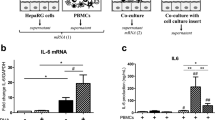Abstract
The asialoglycoprotein receptor (AGPR) is responsible for the catabolism of acute phase proteins. The effects of inflammation-related cytokines on the expression of AGPR were investigated in HepG2 cells derived from a human hepatoblastoma cell line. Binding studies, using a [125I]-labeled asialo-orosomucoid ligand, revealed that AGPR numbers on cell surfaces were increased by interleukin-1 (IL-1), interleukin-6 (IL-6), and tumor necrosis factor (TNF). In cells treated with IL-1, IL-6, or TNF, immunohistochemical staining with an anti-AGPR monoclonal antibody demonstrated augmented expression. Pulse labeling analysis, using [35S]-labeled methionine, showed newly synthesized AGPR in both the precursor and the mature forms. When IL-1, IL-6, and TNF were added to the culture medium, total synthesis of AGPR (sum of the mature and precursor forms) was increased. In addition, the relative proportion of the synthesized precursor form of AGPR was higher in cytokine-treated than in untreated cells, suggesting that these cytokines augment the synthesis of AGPR, particularly in the stage prior to glycosylation.
Similar content being viewed by others
References
Kushner I. The phenomenon of the acute phase response. Ann N Y Acad Sci 1982;39–48.
Nijsten MWN, De Groot ER, Ten Duis HJ, et al. Serum levels of interleukin-6 and acute phase responses. Lancet 1987;17:921.
Gauldie J, Richards C, Harnish D, et al. Interferon β2/B-cell stimulatory factor type 2 shares identity with monocyte-derived hepatocyte-stimulating factor and regulates the major acute phase protein response in liver cells. Proc Natl Acad Sci USA 1987;84:7251–7255.
Baumann H, Richards C, Gauldie J. Interaction among hepatocyte-stimulating factors, interleukin 1, and glucocorticoids for regulation of acute phase plasma proteins in human hepatoma (Hep G2) cells. J Immunol 1987;139:4122–4128.
Perlmutter DH, Dinarello CA, Punsal PI, et al. Cachectin/ tumor necrosis factor regulates hepatic acute-phase gene expression. J Clin Invest 1986;78:1349–1354.
Morell AG, Irvine RA, Sternlieb I, et al. Physical and chemical studies on ceruloplasmin, V. Metabolic studies on sialic acidfree ceruloplasmin in vivo. J Biol Chem 1968;243:155–159.
Hudgin RL, Pricer WE Jr, Ashwell G. The isolation and properties of a rabbit liver binding protein specific for asialoglycoproteins. J Biol Chem 1974;249:5536–5543.
Schwartz AL, Fridovich SE, Knowles BB, et al. Characterization of the asialoglycoprotein receptor in a continuous hepatoma line. J Biol Chem 1981;256:8878–8881.
Schwartz AL, Bolognesi A, Fridovich SE. Recycling of the asialoglycoprotein receptor and the effect of lysosomotropic amines in hepatoma cells. J Cell Biol 1984;98:732–738.
Knowles BB, Howe CC, Aden DP. Human hepatocellular carcinoma cell lines secrete the major plasma proteins and hepatitis B surface antigen. Science 1980;209:497–499.
Audus T, Geiger T, Hirano T. Action of recombination human interleukin 6, interleukin 1β and tumor necrosis factor α on the mRNA induction of acute-phase proteins. Eur J Immunol 1988; 18:739–746.
Baenziger JU, Maynard Y. Human hepatic iectin, physiochemical properties and specificity. J Biol Chem 1980;55:4607–4613.
Engvall E, Perlmann P. Enzyme-linked immunosorbent assay (ELISA) quantitative assay of immunoglobulin G. Immunochemistry 1971;8:871–874.
Kohgo Y, Nakaya R, Mogi Y, et al. Production and characterization of specific asialoglycoprotein receptor antibody. Hybridoma (in press).
Greenwood FC, Hunter WM, Glover JS. The preparation of131I-labelled human growth hormone of high specific radioactivity. Biochem J 1963;89:114–123.
Schwartz AI, Fridovich SE, Knowles BB, et al. Characterization of the asialoglycoprotein receptor in a continuous hepatoma line. J Biol Chem 1981;256:8878–8881.
Schwartz AL, Rup D. Biosynthesis of the human asialoglycoprotein receptor. J Biol Chem 1983;258:11249–11255.
Spiess M, Lodish HF. Sequence of a second human asialoglycoprotein receptor: Conservation of two receptor genes during evolution. Proc Natl Acad Sci USA 1985;82:6465–6469.
Bischoff J, Lodish HF: Two asialoglycoprotein receptor polypeptides in human hepatoma cells. J Biol Chem 1987;262: 11825–11832.
Moshage HJ, Roelofs HMJ, Van Pelt JF, et al. The effect of interleukin-1, interleukin-6 and its interrelationship on the synthesis of serum amyloid A and C-reactive protein in primary cultures of adult human hepatocytes. Biochem Biophys Res Commun 1988;155:112–117.
Andus T, Geiger T, Hirano gnT, et al. Recombinant human B cell stimulatory factor 2 (BSF-2/IFN-β 2) regulates β-fibrinogen and albumin mRNA levels in Fao-9 cells. FEBS Lett;221:18–22.
Author information
Authors and Affiliations
Additional information
This study was supported, in part, by grants 03671370 and 03151001 from the Ministry of Education, Culture, and Science of Japan.
Rights and permissions
About this article
Cite this article
Nakaya, R., Kohgo, Y., Mogi, Y. et al. Regulation of asialoglycoprotein receptor synthesis by inflammation-related cytokines in HepG2 cells. J Gastroenterol 29, 24–30 (1994). https://doi.org/10.1007/BF01229069
Received:
Accepted:
Issue Date:
DOI: https://doi.org/10.1007/BF01229069




